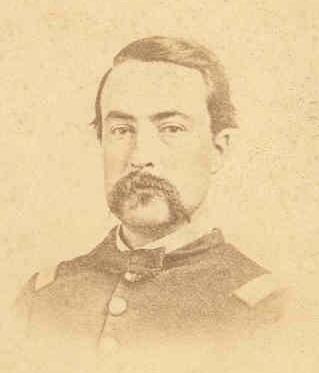
The Battle of Palmito Ranch, also known as the Battle of Palmito Hill, is considered by some criteria as the final battle of the American Civil War. It was fought May 12 and 13, 1865, on the banks of the Rio Grande east of Brownsville, Texas, and a few miles from the seaport of Los Brazos de Santiago, at the southern tip of Texas. The battle took place more than a month after the general surrender of Confederate forces to Union forces at Appomattox Court House, which had since been communicated to both commanders at Palmito, and in the intervening weeks the Confederacy had collapsed entirely, so it could also be classified as a postwar action.

Texas declared its secession from the Union on February 1, 1861, and joined the Confederate States on March 2, 1861, after it had replaced its governor, Sam Houston, who had refused to take an oath of allegiance to the Confederacy. As with those of other states, the Declaration of Secession was not recognized by the US government at Washington, DC. Some Texan military units fought in the Civil War east of the Mississippi River, but Texas was more useful for supplying soldiers and horses for the Confederate Army. Texas' supply role lasted until mid-1863, when Union gunboats started to control the Mississippi River, which prevented large transfers of men, horses, or cattle. Some cotton was sold in Mexico, but most of the crop became useless because of the Union's naval blockade of Galveston, Houston, and other ports.

Walker's Greyhounds was the popular name for a division of the Confederate States Army under Major-General John George Walker, composed exclusively of units from Texas. It fought in the Western Theater and the Trans-Mississippi Department, gaining its nickname because the men were able to move long distances rapidly on foot.

The 1st Alabama Cavalry Regiment was a cavalry regiment recruited from Southern Unionists that served in the Union Army during the American Civil War. It was the only predominantly-white Union regiment from Alabama. Of the 2,678 white Alabamians who enlisted in the Union Army, 2,066 served in the 1st Alabama Cavalry.

Hamilton Prioleau Bee was an American politician in early Texas; he was secretary of the Texas Senate in 1846. He served nearly 10 years as representative to the state house beginning in 1849, and for one term as Speaker of the Texas House of Representatives.

The 1st Cherokee Mounted Rifles was a Confederate States Army regiment which fought in the Indian Territory during the American Civil War. It was formed from the merger of two predecessor units the First Regiment of Cherokee Mounted Rifles, and the Second Regiment of Cherokee Mounted Rifles. The first commander was Col. John Drew, while the second was Stand Watie.
Galvanized Yankees was a term from the American Civil War denoting former Confederate prisoners of war who swore allegiance to the United States and joined the Union Army. Approximately 5,600 former Confederate soldiers enlisted in the "United States Volunteers", organized into six regiments of infantry between January 1864 and November 1866. Of those, more than 250 had begun their service as Union soldiers, were captured in battle, then enlisted in prison to join a regiment of the Confederate States Army. They surrendered to Union forces in December 1864 and were held by the United States as deserters, but were saved from prosecution by being enlisted in the 5th and 6th U.S. Volunteers. An additional 800 former Confederates served in volunteer regiments raised by the states, forming ten companies. Four of those companies saw combat in the Western Theater against the Confederate Army, two served on the western frontier, and one became an independent company of U.S. Volunteers, serving in Minnesota.

32nd Regiment Indiana Volunteer Infantry was a Union Army infantry regiment during the American Civil War. It was also known as Indiana's "1st German" regiment because its members were mainly of German descent. Organized at Indianapolis, the regiment's first recruits mustered into service on August 24, 1861. From 1861 to 1865, the 32nd Indiana was attached to the first Army of the Ohio and the Army of the Cumberland, where it served in the Western Theater.

Samuel Henry Starr was a career United States Army officer, regimental commander and prisoner of war. A collection of his letters provide a rare view of military life, the War with Mexico, Indian conflicts, the Civil War, his fall from grace, recovery and post Civil War service. Despite his rough demeanor he was a religious man and reflective of the times he served.

The 1st Tennessee Cavalry Regiment was a cavalry regiment that served in the Union Army during the American Civil War. It was also known as 1st East Tennessee Cavalry.
The 3d Arkansas Cavalry Regiment (1861–1865) was a Confederate Army Cavalry regiment during the American Civil War.
The 30th Arkansas Infantry (1862–1865) was a Confederate Army infantry regiment during the American Civil War. This regiment was also called the 5th Arkansas Cavalry, the 5th Trans-Mississippi Regiment or 39th Regiment after April, 1863. This regiment was converted to mounted infantry for Price's Missouri Expedition in 1864 and was known as Rogan's Arkansas Cavalry. There were two regiments officially designated as the 30th Arkansas Infantry. The other 30th Arkansas served east of the Mississippi River and was redesignated as the 25th Arkansas Infantry.
The 3rd Arkansas Consolidated Infantry (1864–1865) was a Confederate Army infantry regiment during the American Civil War. The regiment is separate from and has no connection with the 3rd Arkansas Infantry Regiment which served in the Confederate Army of Northern Virginia and is also separate from the 3rd Regiment, Arkansas State Troops, which participated in the Battle of Wilson's Creek.

Ira Wallace Claflin was a United States Army West Point regular officer who took command of the 6th US Cavalry during the critical days of July 1863 during the Gettysburg Campaign. He was an instructor of Union cavalry tactics for West Virginia and later taught at West Point.
The 7th Regiment Indiana Cavalry was a cavalry regiment that served in the Union Army during the American Civil War.

The 1st New York Cavalry Regiment was a regiment in the Union Army in the American Civil War. It was also known as the Lincoln Cavalry, Carbine Rangers, Sabre Regiment, and 1st United States Volunteer Cavalry. It was mustered in from July 16 to August 31, 1861. It was mustered out June 27, 1865.
The 3rd Massachusetts Volunteer Cavalry Regiment was a cavalry regiment that served in the Union Army during the American Civil War. It was organized by consolidating the 41st Massachusetts Mounted Infantry and the 2nd Battalion Massachusetts Cavalry on June 17, 1863. The regiment served with the XIX Corps, Army of the Gulf during the Red River Campaign in 1864. Its heaviest combat during this campaign took place during the Battle of Sabine Crossroads.
Ebenezer "Ben" Magoffin (1817-1865) was a Confederate officer in the American Civil War who carried a Missouri State Guard's colonel's commission and became a prominent figure in the early phase of the war in Missouri. He was sentenced to death by a Union Army military commission in 1862, but was spared execution after Kentucky Governor Beriah Magoffin pleaded for the life of his brother with Abraham Lincoln.











